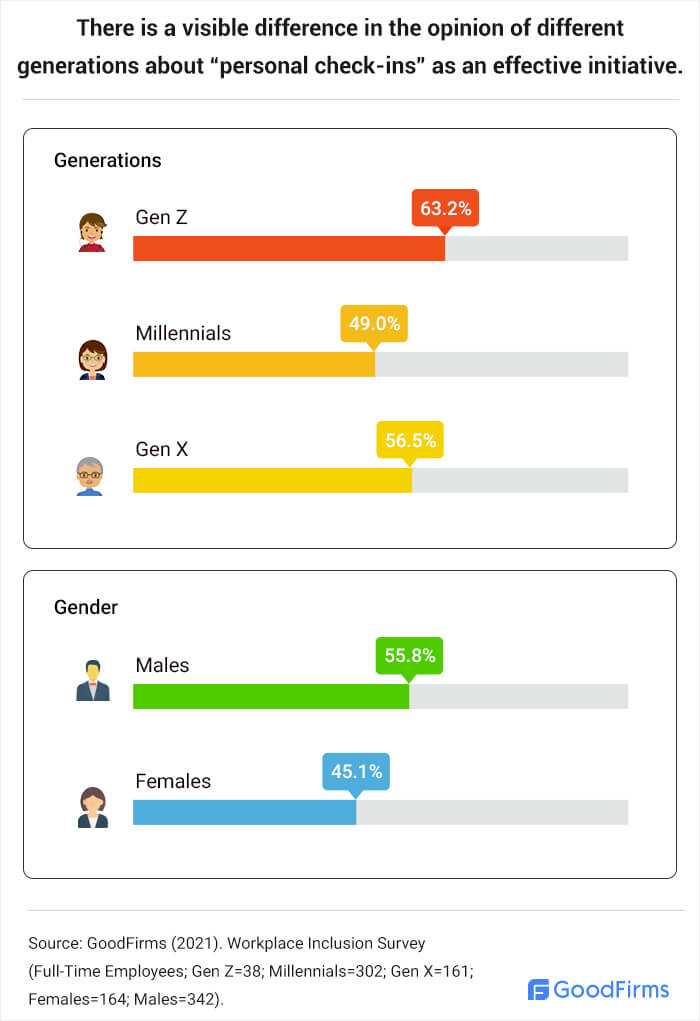Diversity and inclusion are the buzzwords right now. There is an increasing awareness among both employees and employers about the importance of having a diverse workforce. GoodFirms surveyed 510 employees across the world to know the characteristics and impact of diversity and inclusion in the workplace. And what initiatives can be taken for the same.
Diversity and inclusion in the workplace are not limited to allowing all employees a chance of representation in important decisions of the organization. In reality, a truly inclusive workplace will implement initiatives right from the hiring stage to day to day activities of employees. And it is not a day’s job. Sometimes creating a completely diverse and inclusive workplace may take months too.
Diversity and inclusion in the workplace are important today as such an environment has multi-faceted benefits. Some of the top reasons to cultivate such a workplace culture are that it will increase employee engagement rate, and the organization will be able to attract and retain better talent. The advantages to the organization here are that the higher the retention rate and innovation, the higher the turnover rate and brand value in the market.
Given the pace at which the need for inclusivity and diversity is increasing in workplaces, it is crucial that organizations start taking measures for the same.
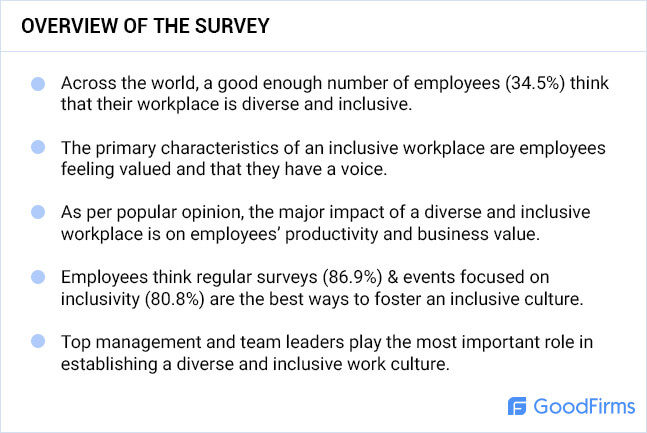
The Detailed Study
A diverse and inclusive environment is the one that makes the employees feel welcome, and at the same time, allows them to shine with their unique qualities. Workplaces around the globe have recognized the importance of inclusion and diversity, and are finding new ways to implement that culture.
Especially for the younger generations of employees, the workplace environment is becoming more and more important. They would rather choose to work in an organization with a diverse culture than the ones which support only a single social or ethnic group.
When asked to rate their workplaces, on a scale of 1-10 for being diverse and inclusive, a significant number of employees (34.5%), marked their workplace as a 10 for the same.
If the viewpoint of different generations is taken into account for rating their workplace, a significant number of them rated their workplace as 10. But Gen Z voted the highest (55.3%) among all.
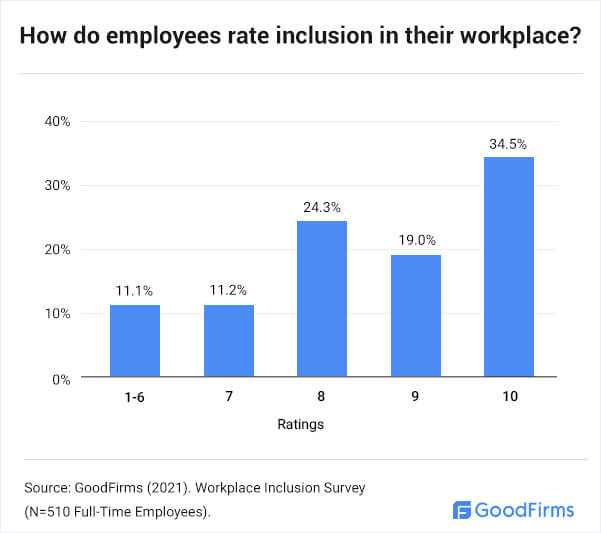
One of the primary reasons for high ratings could be the increasing awareness among employers and employees alike about the importance of diversity in the workplace. Having said that, it is important to keep in mind that diversity and inclusion are a lot more than just policies and headcounts. While many companies are trying to create an inclusive environment, a lot of them don’t understand what it actually means to be one. As per Forbes Insights Research on Global Diversity and Inclusion, 75% of Fortune 1000 companies have diversity initiatives, and 70% of them believe that they have been effective in recruiting ‘diverse’ employees, but in reality, only 11% of them understand the actual concept.
Read the detailed article below to understand the benefits of diversity and inclusion in the workplace, who can help cultivate such an environment, and some expert-recommended initiatives for ensuring that the workplace culture is inclusive.
Primary Characteristics of an Inclusive Workplace
Most leaders today agree that having an inclusive workplace is crucial but it is easier said than done. The meaning of being inclusive will vary from one organization to another. Some of the top characteristics of an inclusive workplace include employees feeling like they have a voice, employees feeling valued, a collaborative environment, opportunities to learn and grow, a sense of belonging, and access to resources.

Employees Feel like they Have a Voice
Of all the other characteristics, a whopping number of participants (83.1%) believe that the most important one is employees feeling like they have a voice in the organizations.
An inclusive workplace is a lot more than just a seat at the table for employees. It means that the diverse workforce in the organization feels included and integrated at all times. Inclusiveness should be deep-rooted in the company culture.
Also, there is a possibility that employees from different cultural backgrounds may be physically represented but in reality, they are often underutilized. This then becomes an issue of presentation vs implementation.
In reality, all employees should be able to share their opinions and thoughts without fear of facing any prejudice for the same. An inclusive leader will take into consideration the opinions of all employees with different views. It not only makes employees feel like they have a voice but also helps the leaders to make better decisions related to the ongoing activities.
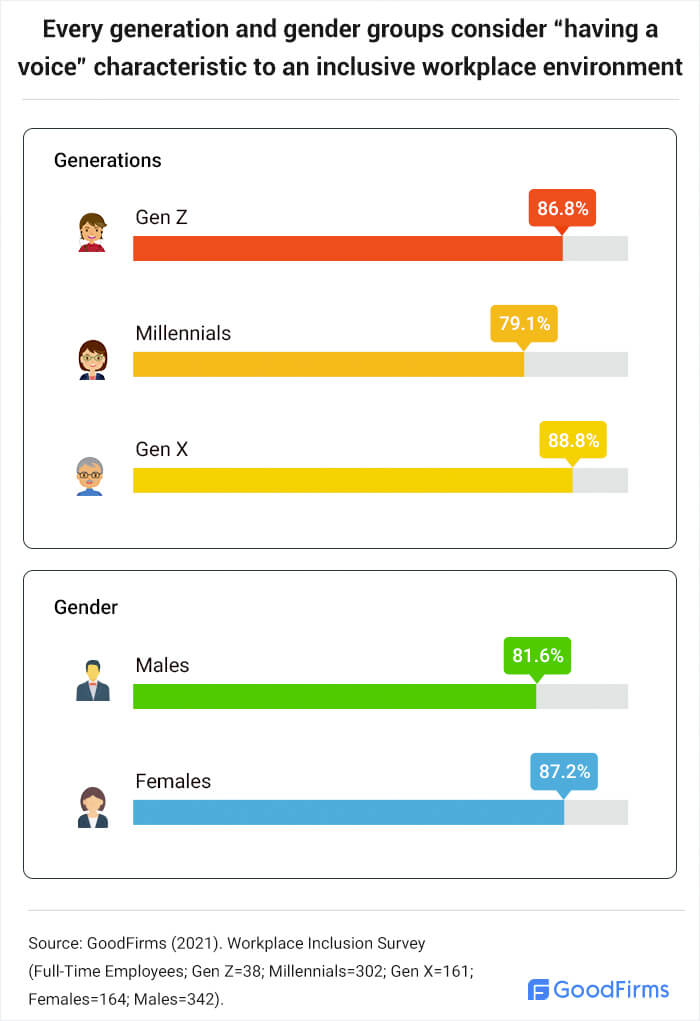
Even though “employees feel like they have a voice” is voted as the most important characteristic overall, the opinion of Gen Z and Millennials differs here. A substantial number of Millennial employees (79.1%) feel that this a crucial characteristic but more number (86.8%) of Gen Z employees feel the same way.
Employees Feel Valued
Employees feeling valued is the second most important characteristic of an inclusive workplace. A substantial percentage (79.2%) of surveyed employees agree with it.
People have a need to feel connected to a common purpose, but they also want to be recognized for their unique qualities. It is important to make employees feel that their unique contributions and skills are valued. One way to achieve that is to have a one-to-one discussion with employees about how their work is contributing to the overall organization’s goals. Acknowledging their smallest achievements at an individual level will show that not only the organization cares about their employees but also wants to become a part of their success.
If the perspective of different generations is taken into consideration here, there is a visible difference in the opinion of Gen Z and Millennials. On the other hand, the opinion of Gen Z and Gen X is quite similar with a lesser difference in the numbers.
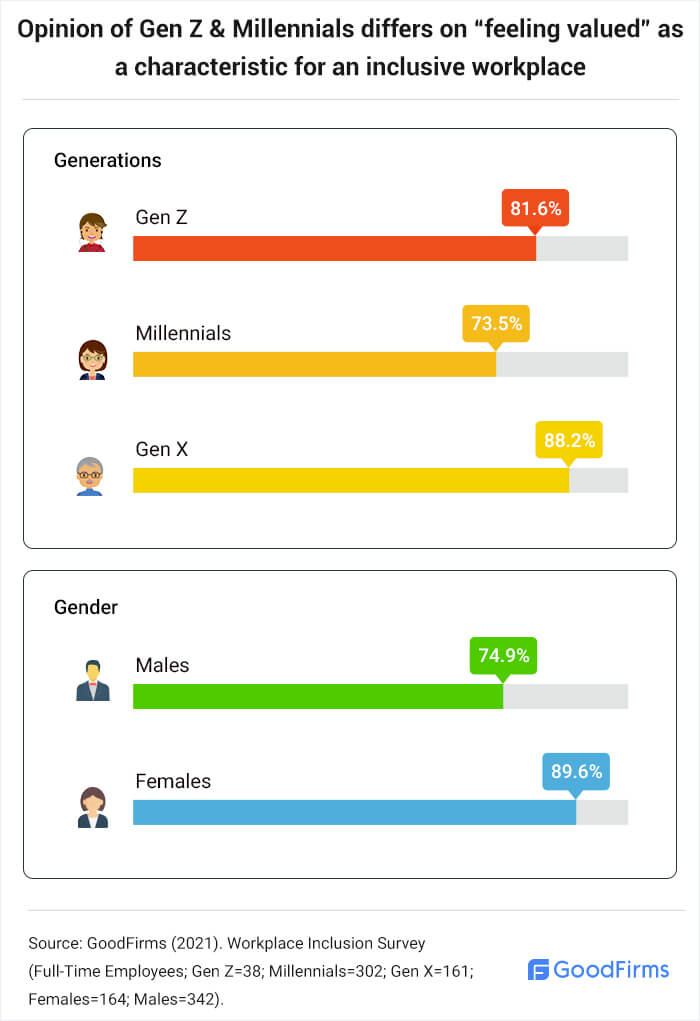
It is important for a great number (81.6%) of Gen Z employees to feel valued in the workplace. Also, 73.5% of Millennials believe it to be an important characteristic of an inclusive workplace.
Impact of an Inclusive Environment on the Workplace
Diversity and inclusion will continue to be an important aspect of workplace culture beyond 2020. The primary reason being that a diverse and inclusive workforce is able to achieve more as compared to their peers. The top two benefits of an inclusive workplace as per the GoodFirms survey are enhanced productivity and improved business value.

Enhanced Productivity
Out of all the possible benefits of an inclusive workplace, enhanced productivity is the top one as per 86.9% of survey respondents.
There are a lot of factors that have an impact on the productivity of employees. One of the major factors being the happiness of an employee in his/her workplace. Happy employees are more likely to give their best to the organization. The correlation between productivity and inclusivity is that such a workplace makes employees feel welcome irrespective of their background.
“Inclusive work environments and productivity go hand in hand,” says Charles Taylor Harris, the Executive Director of Get Golden Visa, “At an inclusive organization, team members feel respected and valued, they feel happy. Happy employees are inclined to give their best back to the organization. They are more creative, high performing, and productive.”
Such a work environment will make employees feel respected and ultimately boost their morale. The high morale of employees will reflect positively on the organization’s turnover. As per a Deloitte study, organizations with inclusive practices at every stage can garner about 30% more revenue per employee.
Moreover, they will also be less likely to leave the organization. Higher employee retention also means less cost of hiring and training new employees.
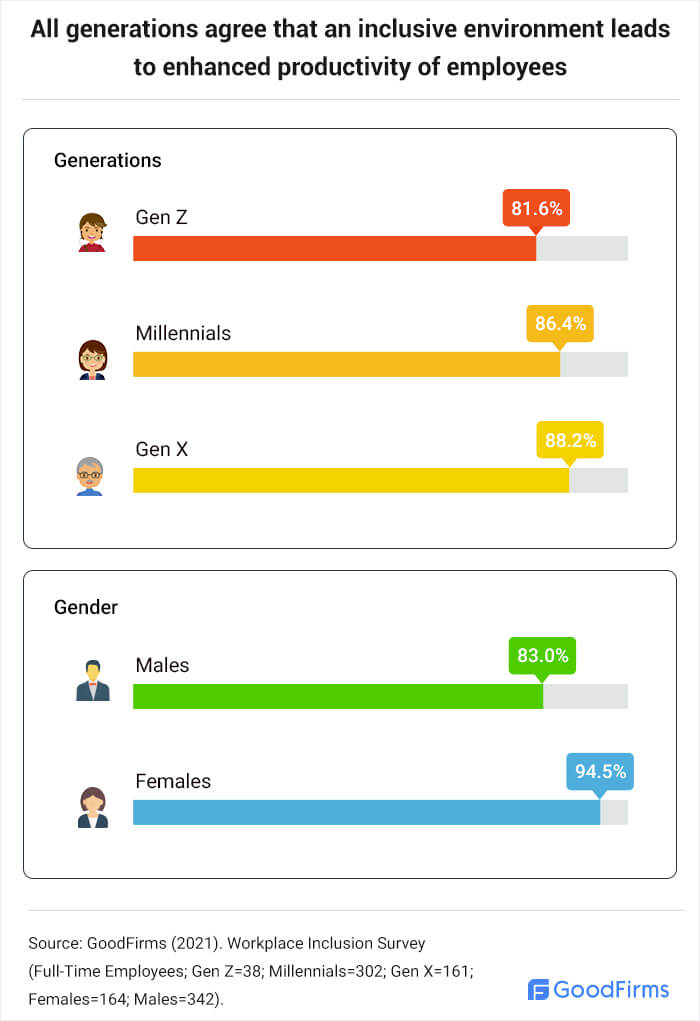
Improved productivity is the top impact of an inclusive organization and all three generations of employees i.e Gen Z, Millennials, and Gen X agree with the same too. They are more or less on the same page with a significant number of them believing that an inclusive and diverse workforce will have a positive impact on productivity.
Improved Business Value
A substantial number of employees (63.9%) believe that the second major impact of an inclusive workplace is an improvement in business value.
Employees are the connecting link between improved business value and an inclusive environment. Today, the employees will choose an organization that doesn’t discriminate and is open about the differences between individuals. As a result, they will feel more satisfied with the work that they do. A higher employee satisfaction rate will lead to better productivity, engagement, and innovation. There is no denying the fact that innovation has become inevitable in highly competitive market conditions. A study shows that entrepreneurs with diverse friendships scored three times higher on the innovation metrics. It ultimately means that a diverse workforce will lead to an increase in innovation in the organization.
The Head of HR at Hal Waldman & Associates, Alison Pearson, states how such an environment will contribute to improving the business value. “An inclusive workplace has a direct correlation to business value. If everyone is welcomed and valued, that will overflow to quality service to make sure that all clients are valued and welcome. If people who visit our office feel like they are welcome and valued, then they are more likely to hire us, which (obviously) will benefit our business,” said Alison.
In spite of a direct relationship between inclusivity and improvement in business value, the response of different generations with respect to this is quite different from each other. There is a major difference in the viewpoint of Gen Z and Millennials. While 76.3% of Gen Z employees think that business value will improve, comparatively fewer numbers (64.2%) of Millennials’ thoughts align with them.
How to Make a Workplace More Inclusive?
The advantages of a diverse and inclusive culture are multifaceted. But creating one doesn’t mean just hiring employees from different backgrounds. To create such a workplace in the true sense, steps need to be taken and implemented at every level of the organizational structure. Some of the possible initiatives for such a workplace include regular employee surveys, events focused on inclusivity, company-wide meetings, frequent, personal check-ins and more.
Regular Employee Surveys & Events Focused on Inclusivity are the Top Choices
Regular employee surveys and events focused on inclusivity seem to be the most important initiatives as per the survey results. An overwhelming majority of employees - 86.9% - are in favor of regular employee surveys whereas 80.8% of employees like the idea of hosting exclusive events for the same.
Regular employee surveys are a great way to let the top management know about what they are doing wrong. Surveys have become necessary because many times even in the most open work environments employees are hesitant to present their opinion to the senior management. However, it is also important to keep in mind that these surveys are helpful only if necessary action is to improve the situation later on.
A Chief Human Resources Officer at Resume.io, Rolf Bax, highlights the importance of anonymous surveys and why they help.
Rolf said, “I think that anonymous surveys are better at gauging employee sentiment and getting honest feedback about what could be done better. We already use one such survey that we send out at the end of each quarter and it has been immensely useful in helping us do things like eliminating gendered, racialized, and ableist language in some of our job descriptions and company-wide internal emails and media. I think approaching the issue using an anonymous survey makes people more comfortable to share their true feelings.”
The positive opinions expressed by different generations of employees for carrying out regular employee surveys are a clear indication of its effectiveness. Both Gen Z and Millennials are largely in favor of regular employee surveys.
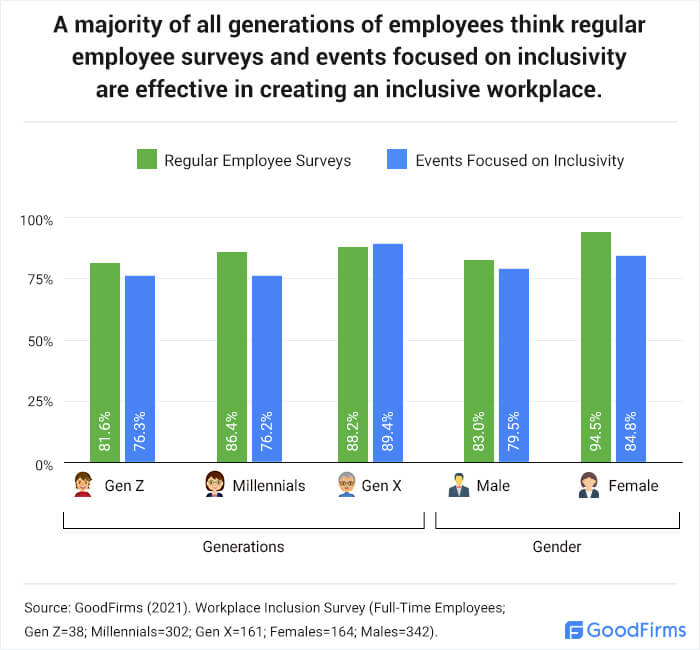
The concept of hosting events focused exclusively on diversity and inclusion in the workplace is slowly gaining momentum. While it is not possible for every organization to host one due to a lot of factors, a great number of organizations are doing something like this to set an example. Gen Z and Millennials support the idea of such events with 76.3% and 76.2% of them voting for them respectively.
Some examples of events focused on diversity & inclusion are:
But, Frequent Personal Check-ins are Important Too
For 52.2% of employees, personal check-ins are the way to go for creating an inclusive workplace. A major reason for employees supporting this initiative is that not every employee will be vocal about their opinions in front of the entire team. They may not even discuss the issues they are facing.
To ensure that such employees are not left out, personal check-ins are a great way to make them feel comfortable and valued. Personal check-in is like having a one-to-one conversation with employees and giving them an opportunity to discuss their problems without the fear of being judged or facing biased behavior from other colleagues.
CJ Xia explains how personal check-ins create a comfortable working atmosphere for everyone. “As an employee, I believe that regular personal check-ins are more effective in creating an inclusive workplace. Personal check-ins from colleagues allow the employees to feel the greatest sense of belonging at work. Check-ins create a valuable channel for dialogue, create the right environment for good relationships, and build harmony between employees and employers,” said CJ Xia, the VP of Marketing & Sales at Boster Biological Technology.
Employers or team leaders should assign a dedicated time in the day, week, or month as per everyone’s convenience to have one-to-one conversations. It is not necessary to discuss only the issues. The conversation can start from something as simple as ‘how the things are on the work front’. They need to make employees feel comfortable and safe so that they eventually open up about any major/minor issues at the workplace.
While a notable number of Gen Z employees (63.2%) think that personal check-ins are an effective way to make employees feel included, the Millennials and Gen X employees have a little different take on the same. As compared to Gen Z, only 49% of Millennial employees feel that personal check-ins are helpful.
Who Plays a Significant Role in Creating an Inclusive Environment?
Everyone in an organization has some role to play in cultivating an inclusive environment. However, the role of some people is more important than the others. As per the GoodFirms survey, the most significant roles are of team leaders, top management, middle-level managers, individuals, human resources officers, and specially appointed officers.
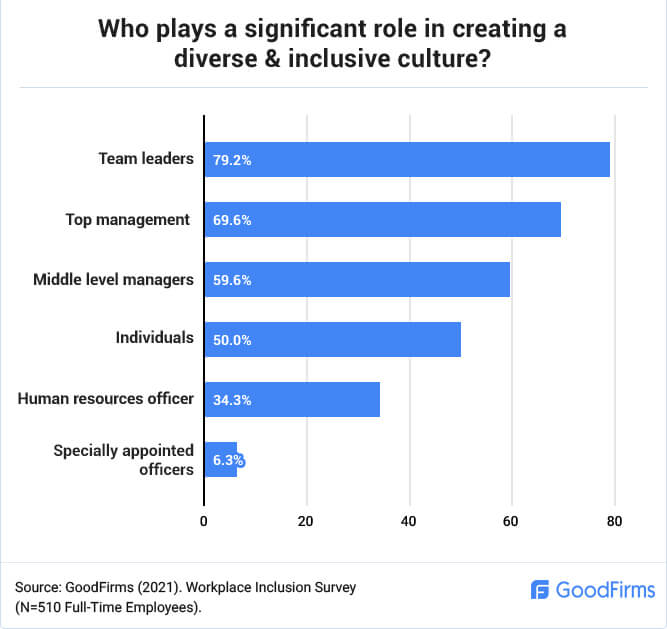
Team Leaders are Believed to Play the Most Significant Role
For achieving something in an organization, every member has a role to play. When it comes to successfully establishing inclusivity, a whopping number (79.2%) of surveyed employees have a perspective that team leaders have the most significant role.
Team leaders are the ones who directly communicate with the employees on a daily basis. This holds even more true in the case of large organizations. Team leads are the ones who are updated daily on the ongoing work and issues faced by their team members. Moreover, it is not always possible for CEOs and business owners to keep in touch with every employee. Hence, team leaders can be more effective in establishing an inclusive and diverse workplace.
One of the ways in which team leaders can be successful in such a workplace culture is by offering an open platform to his/her team members. Despite that, there will be employees who may not discuss their problems. In such a case, the personal check-in initiative will help the team leaders to help them open up and be more comfortable.

Agreeing with the overall vote for team leaders playing an important role are the different generations of employees. Both Millennials and Gen Z employees also think that team leaders can bring about a real change in the workplace culture.
Top Management Ranks Second for Playing an Important Role
After the team leaders, the next role is of the top management. A noteworthy number (69.6%) of surveyed employees believe that top management will also contribute to creating a diverse and inclusive environment.
Top management because employees will look up to those in the senior-most position in the organization. A CEO or business leader is the one who can set an example for others to follow. They are the ones who will model a company’s working environment in the way they want to continue in the future too.
Adam Chase, President of Music Minds, explains the hierarchy through which an inclusive culture can be established. He said, “ I feel very strongly that diversity and inclusion initiatives need to start from the very top. The company CEO or President has to make the executive decisions, draft the plan, and get their managers on board. Managers are responsible for helping to roll out the initiative.”
A basic and effective way in which top management can achieve it is by using inclusive language and encouraging the employees to do the same. Language is powerful and has the potential to set the desired tone of communication within the company without making it feel like an order. Another option is that the top management can partner with corporate training companies, to make sure that the values of inclusivity and diversity are ingrained in the company culture.

There is a visible difference in the take of Gen Z and Millennial employees on the role of top management in creating a diverse work culture. On one hand, a notable number (66.6%) of Millennials think that the role of top management is pivotal, on the other hand, only 36.8% of Gen Z employees feel the same way.
Specially Appointed Officers Have the Least Significant Role
The corporates have introduced a new leadership position of a Chief Diversity Officer. The basic duty of such an officer is to change the existing workplace culture and make it a more inclusive and diverse one. Despite it being an important position in the current scenario, only 6.3% of surveyed employees think that a specially appointed officer will play a significant role.
More often than not specially appointed officers fail at their job. That’s because many companies hand over an unreasonable number of problems to their chief diversity officer and have unrealistic expectations from them.
Also, a specially appointed officer will be ultimately under the top management in the hierarchy. So, it can be said that the origin of creating an inclusive environment ultimately starts with the top management, and later on the responsibility is handed over. If the top management is not concerned about these issues, then there is nothing that a specially appointed officer can do.
When it comes to the implementation of policies for a diverse and inclusive environment, the real responsibility falls on team leaders as they are the ones who are in direct contact with the employees. They know what is going on on a daily basis and what are the issues that employees face. Therefore, team leaders will also have a more significant role as compared to a specially appointed officer.
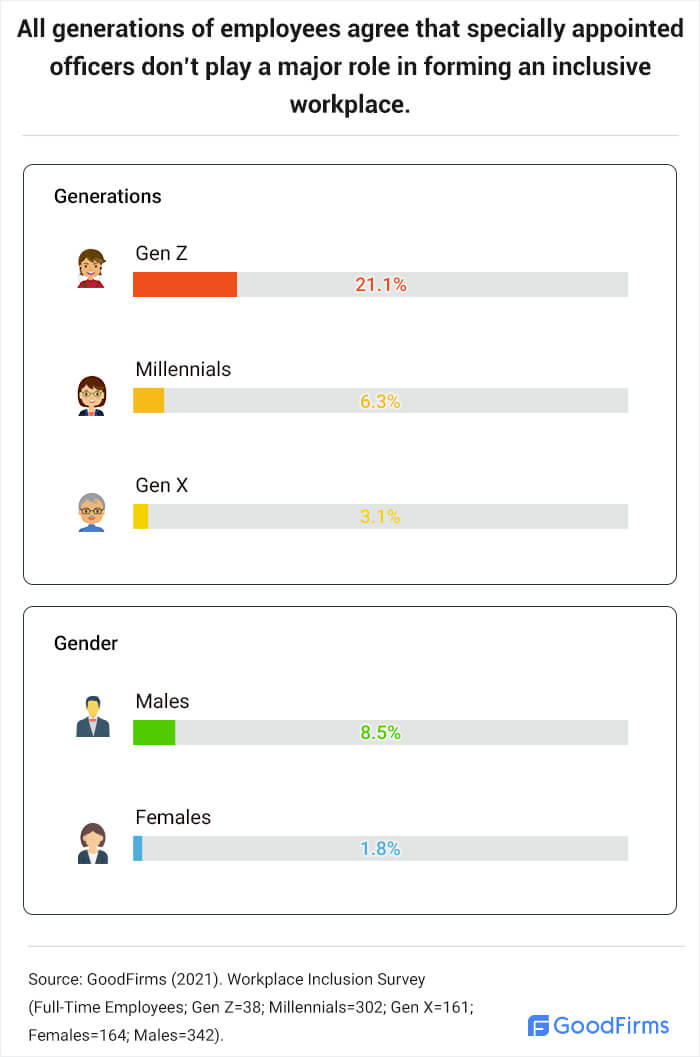
In the opinion of different generations of employees, only 36.8% of Gen Z employees think that a specially appointed officer is significant. Whereas a higher percentage (66.6%) of Millennial employees are of the opinion that such an officer is crucial in creating an inclusive workplace.
Conclusion
The concept of diversity and inclusion in the workplace is beneficial for the organization as well as employees. The younger generation of employees i.e Gen Z and Millennials are especially the ones who will prefer an organization with a diverse workforce. As they are the future of the workforce, it is inevitable that the organizations take into consideration their preferences.
An organization can be truly considered inclusive when all its employees feel that they have a voice and are valued irrespective of their social status or background. To establish such a work environment, top management and team leaders are the ones who have the most crucial role. In employees’ opinion, regular employee surveys, frequent personal check-ins, and events focused on inclusivity will help ingrain inclusivity in the workplace environment.
About the GoodFirms’s Diversity & Inclusion Survey
GoodFirms surveyed 510 working professionals.
The survey participants are primarily males (67.1%), along with females (32.2%). When it comes to the age groups distribution among the respondents, 7.5% are Gen Z (18-24), 59.2% are Millennials (25-39), 31.6% are Gen X (40-59), and the remaining 1.8% are Baby Boomers (60+).
Apart from these demographics, the survey participants came from diverse geographical locations like the United States (36.9%), Canada (13.7%), Australia (7.6%), United Kingdom (2.5%), and India (15.9%).
The participants were asked questions about diversity and inclusion at their workplace. Starting with rating their workplace for being diverse and inclusive, the respondents were asked to state the characteristics of such a workplace, and the initiatives that can be taken to make a workplace diverse and inclusive. Moreover, the participants were asked to state the major impact of an inclusive culture and who plays a significant role in creating one.
We humbly thank our Research Partners who helped us gather survey participants and contributed with insights for the research.
* For any queries, drop an email to [email protected]
- 365 Digital Consulting
- A-HR
- A2 Design
- A2 System Mobile,Research
- A2ZVA
- Abhigamyah Technovations
- Absolute Digital
- Ace Infoway
- Actupon Technologies
- Adastra Bulgaria
- AddWeb Solution
- AdEngage
- Adept Technologies
- Adimen
- Adsum Originator
- Advanced Analytics and Research Lab
- AdzGuru
- Affluence PR
- Ajinkya Global Adventure
- Aksoy Araştırma
- ALL-PRO Bookkeeping Services
- Altoros Labs
- Amptize
- Anderson Collaborative
- AndLeads
- Angle2
- AntStack Technologies Pvt Ltd
- Apero Solutions
- Apify
- Applover
- AppMomos
- Appssemble
- APPVALES
- Arcadia Bytes
- Argona Partners
- ARNSS Innovation
- Ascii System
- Askgalore Digital
- Asterism Infosoft Pvt Ltd
- Atma
- Aveshost
- Aymen Jarouih
- BABEL Agency
- Bastion Elevate
- BD Server Hosting
- Bespoke Design
- Best Heads
- BKA Content
- Blaize
- BrandDad Digital
- BrandGeko
- Breadnbeyond
- BroSolutions
- Brounie
- Bungarra
- Candor
- Carver Cantin and Mynarich
- Cascadia Training
- CCC International
- Ceemi Agency
- Central Hubspot
- Chowdhury Aktar & Associates
- Ciel Consulting
- CIENCE
- COAX Software
- CodeCoda
- Codepxl
- CoderKube Technologies
- Codility Solutions
- Commercial Translation Centre
- Contact 1-2-1
- ConvrtX
- Coquewebsite
- CosmoDoggo
- Curve
- Dapgen Technology Private
- DataGators
- DenBe Computer Consulting
- Design Start
- Dgmark Agency
- Digiadlab
- DIGITAL OPERATIVE
- Digital Partner
- Digital Third Coast
- DigitalDesign.NYC
- Dignexus
- dion
- Dividato
- Dixtra
- DNA DIGITAL MARKETING
- DNAVI
- Docforce
- DQM Software Inc.
- DreamWalk Apps
- Duckpin
- E-Vision Corp
- Eastern Peak
- echoinnovateit
- Eco Web Hosting UK
- eContentsol
- Ecotech IT Solutions
- Elecsis
- Elite Graphix
- Elite TransLingo
- eMarspro.Inc
- Eminenture
- Empex Digital
- EmpowerD Tech
- Eptins
- Equinox Information Services
- eSEOspace
- Espay Exchange
- Evernetica
- Excelify Solutions
- Excite Media
- Firewire Digital
- Fisheye Solutions
- FlareMark
- ForwardSprint Consulting
- Frontier Consulting
- Gamajun Games
- Genuineq
- Glenn Website Design
- Goldenlink Digital Media
- Gorrion Software House
- GOTO MARKETERS INC
- GoWebLive
- Greek Mapple
- Groove Jones
- Growth360
- Growwwise
- Gustonera
- Hexis Technology Hub
- HireTester
- Hitz Digital Marketing
- HypeLife Brands
- IBR Infotech
- IBR Infotech
- IceVayne Games
- Ideofuzion pvt ltd
- IllustReign IT Solution
- Imagine
- IMTC
- Inclusion The Cloud Company
- India Blockchain Alliance
- INETWORK Middle East
- Inflexion Software
- INGCO International
- Innovatily
- Invisible Ink
- Jacobs Development
- JaxonLabs LLC
- JDV Technologies
- Ji Web Lab Solutions
- JP Web Agency
- Lafont Innovation LLC
- Lanka Designer Solutions (Pvt) Ltd
- LanSoft
- LatAm Intersect PR
- Lead Tycoons
- Leading Solution
- LiaisonIT INC
- Lift Digital Marketing
- Light-it
- Liventus
- Lizard Global
- LMNts Marketing
- Magicmind technologies Limited
- Magister Marketing and Consultancy
- Marketing Launch Team OÜ
- MastakStudio
- Medwave Billing & Credentialing
- Meerkat Marketing
- MegaZebra
- Meson Digital Marketing Agency
- Microad Blade Indonesia
- Mindshare Labs, Inc
- Mintosoft
- MobMaxime
- MOST 2414
- Mylestone HR Consulting
- N-Development
- NDIMENSION LABS
- Neev Pathar Architects & Interior
- Neklo
- Neotech Solutions
- Nivahata Technologies
- Novasta Bilişim Ltd.Şti
- OpenXcell
- Optimize Goal
- ORIMOS.DEV SRL
- Outsource in Pakistan
- Pairroxz
- PengYi Labs
- Pepper Interactive Communication
- Pharos Softtech Private Limited
- Phoenix Training and Development
- Photozland
- Pixelfly Innovations Pvt Ltd
- Prometeo
- Psybrtech Initative
- Pulsar
- quality.code
- Rambhapuri Technologies
- RAVE
- RavSam Web Solutions
- Ridgemax Solutions
- Risivonne Investments
- RW Infotech Private Limited
- sA.design
- Sahal Accounting Services
- SaM Solutions
- SBR Technologies
- Scalan Labs, LLC
- SEO Kings
- SEOCompanyinDelhi.net
- ServerGuy
- Seven Boats Info-System Pvt. Ltd
- Shape My Content
- Shopify Pro New York
- Shyena Tech Yarns Pvt Ltd
- Sibers
- Siddhi Infosoft
- Silicon Graphics
- SIPSA
- SJ Solutions & Infotech
- SJ Solutions & Infotech
- Smart Voice Studio
- Softpulse Infotech
- Solid Hosting South Africa
- SOLUNTECH
- Solution Mentors Inc.
- Sorcible
- Sosene Company Limited
- Spica Technologies Ltd
- StableWP
- SunHouse Marketing
- Superb Digital Limited
- Supplyant
- Sure Oak
- Tech ICS
- Techamic Solutions
- TECHDesign
- TechDilation
- Technoton Engineering
- Techxide
- THATWARE LLP
- The Evenstar
- The Franatics
- THE MANPOWER COMPANY
- The Telemarketing Company
- Thoroughbred Solutions
- Tiger Systems Ltd
- Tigerfish Software
- Trilight Security
- True Tech Professionals
- Tsukiden Global Solutions Inc.
- TUCU Managed IT Services Inc
- UBX Cloud
- UKR Shipping LLC
- Ultimate Systems
- Unicorn Road, LLC
- Valen Digital
- Velvot Nigeria Limited
- Venum Agency
- Vidhema Technologies Pte Ltd
- Visualwebz
- Volumetree
- Volumetree
- Votan Ventures
- VTI Cloud
- Vuemobi Local Marketing
- Web Masters Technologies
- WEB-RECRUITERS
- webbingstone
- WeDevlops.com
- Well Made Software
- WeSoftYou LLC
- Zencode Technologies Pte Ltd
- ZXSCRIPT


